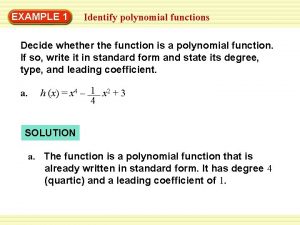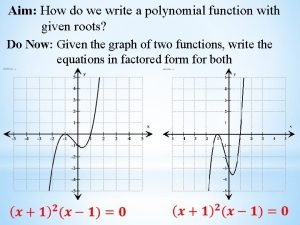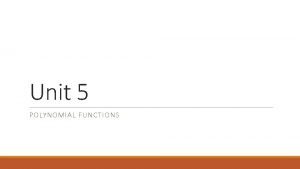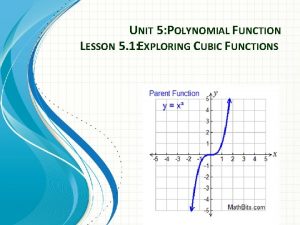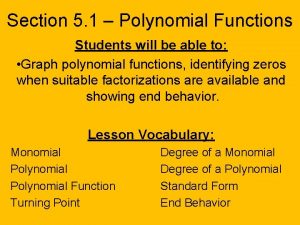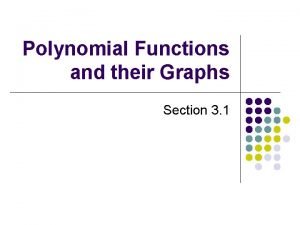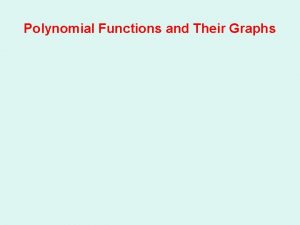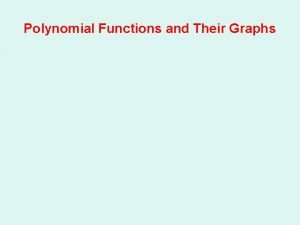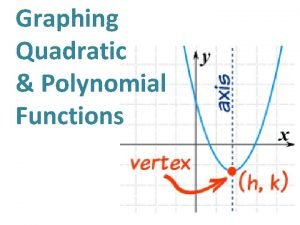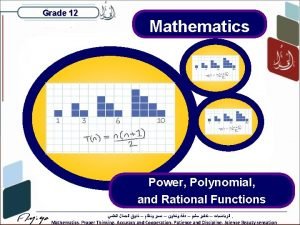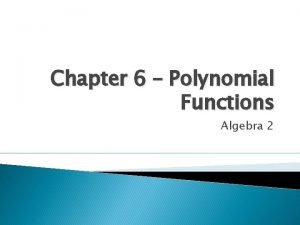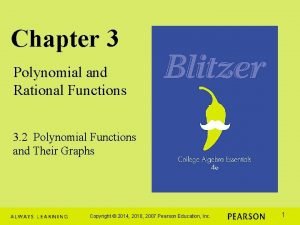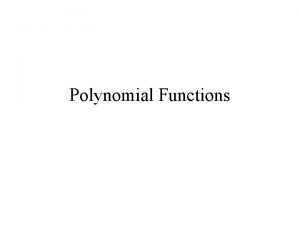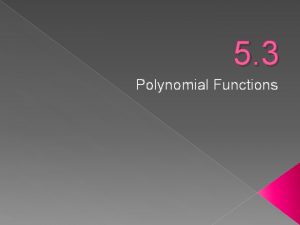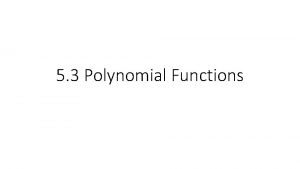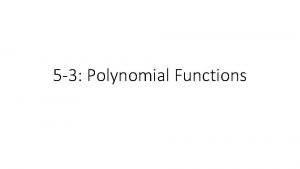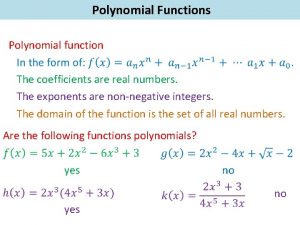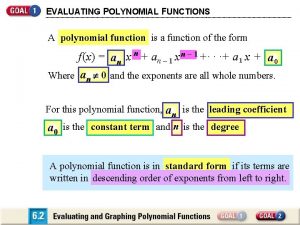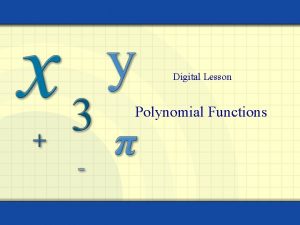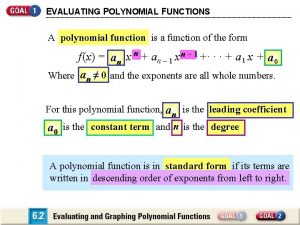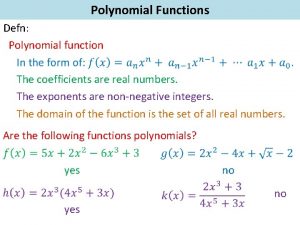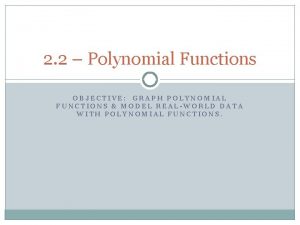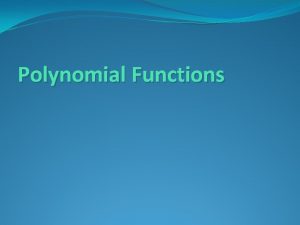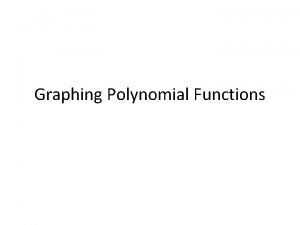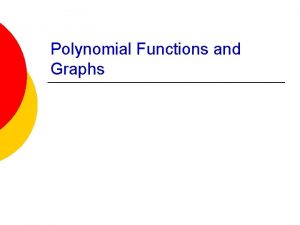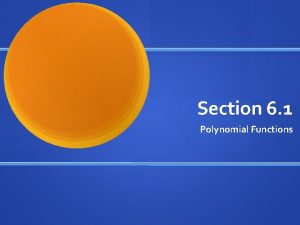POLYNOMIAL FUNCTIONS What is a polynomial function What


















- Slides: 18

POLYNOMIAL FUNCTIONS

What is a polynomial function? What is a polynomial? The sum or difference of two or more algebraic terms (monomials) A polynomial equation used to represent a function is called a polynomial function Example: Quadratic Function f(x) = 4 x 2 – 3 x + 2 f(x) = 2 x 3 + 4 x 2 – 5 x + 7 Cubic Function

Do Now: What does it mean to evaluate a function? Plug in or substitute what is in the parenthesis for x in the function Evaluate p(2) � p(x) = x 2 + 3 x + 4 p(2) = 22 + 3(2) + 4 = 14 Evaluate p(b+1) � p(x) = x 2 + 3 x + 4 p(b+1) = (b+1)2 + 3(b+1) + 4 = b 2 + 2 b + 1 + 3 b + 3 + 4 = b 2 + 5 b + 8

Vocabulary Degree - refers to the highest exponent of a function Leading Coefficient - is the coefficient of the term with the highest degree Example: What is the degree and leading coefficient of: 5 x 2 + 2 x + 1 D: 2, LC: 5 D: 4, LC: 7 7 x 4 + 3 x 2 + x - 9

Graphs of polynomial functions • What relationship is there between the degree of the function and the maximum number of zeros? The degree tells you how many roots you have • What do you notice about the degree and number of humps/ curves in the graph? The degree is one more than the number of

Domain THE SET OF ALL POSSIBLE INPUT VALUES. INDEPENDENT VARIABLE X NOTATION: (-∞<X<∞) OR (-8≤X≤ 9) INTERVAL NOTATION (-∞, ∞) OR [-8, 9]

Range The set of all possible output values. dependent Variable f(x) (also known as y) Notation: (-∞<f(x)<∞) Or (-8≤f(x)≤ 9) Interval Notation (-∞, ∞) Or [-8, 9]

Extrema Extreme values for f(x) Minimum-floor of the graph Maximum-ceiling of the graph Not many graphs of functions will have both Some functions will have neither

Interval of Increase/Decrease Describes the graph as you move left to right. Use same notation as Domain/Range Some functions will have multiple intervals-these have to be described separately

Increasing, Decreasing, and Constant Intervals An interval is the set of all real numbers between two given numbers A function f is increasing on an interval if as x increases, then f(x) increases. A function f is decreasing on an interval if as x increases, then f(x) decreases. A function f is constant on an interval if as x increases, then f(x) remains the same.

Increasing, Decreasing, Constant Intervals Find the interval(s) over which the interval is increasing, decreasing and constant?

Increasing, Decreasing, Constant Intervals f(x) is increasing in the intervals f(x) is decreasing in the interval (-1, 1).

Zeros Values of x that make f(x)=0 Can be determined algebraically (by solving) Can be determined graphically (by observation) Also known as roots, solutions, or x-intercepts

Intercepts Places where the function crosses an axis. Y-intercepts occur when x=0. X-intercepts-see previous slide. Not every function will have them. Some functions will cross the x-axis, but not the y-axis. Some functions will cross the y-axis, but not the x-axis.

End Behavior What happens to f(x) as x goes to infinity in either direction. Two parts. Notation: As x -∞, f(x) something, and As x +∞, f(x) something. What the somethings are has to be determined from observation.

• For any polynomial function, the domain is all real numbers • For any polynomial function of odd degree, the range is all real numbers • The graph of any odd degree function has at least one x intercept

End Behavior

End Behavior
 Identifying polynomial functions
Identifying polynomial functions Polynomial function parent function
Polynomial function parent function End behavior of power functions
End behavior of power functions Matplotlib inline
Matplotlib inline How to divide a polynomial by another polynomial
How to divide a polynomial by another polynomial Unit 5 polynomial functions homework 4
Unit 5 polynomial functions homework 4 Structure in graphs of polynomial functions
Structure in graphs of polynomial functions 5-1 polynomial functions
5-1 polynomial functions Types of polynomials based on degree
Types of polynomials based on degree End behavior how to find
End behavior how to find Graphing polynomial functions
Graphing polynomial functions Investigating graphs of functions for their properties
Investigating graphs of functions for their properties Investigating graphs of functions for their properties
Investigating graphs of functions for their properties Polynomial function form
Polynomial function form Polynomials are in standard form
Polynomials are in standard form حدد مجال الدالة
حدد مجال الدالة Polynomial expression standard form
Polynomial expression standard form Chapter 4 polynomial and rational functions
Chapter 4 polynomial and rational functions Chapter 3 polynomial and rational functions
Chapter 3 polynomial and rational functions
